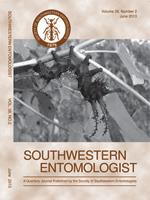We investigated foraging movements by adult female convergent lady beetles, Hippodamia convergeas Guerin-Meneville, on wheat, Triticum aestivum L., growing in 1.8 × 1.8 m plantings in a greenhouse with a soil floor. The wheat was planted to simulate wheat in a typical production field. One planting was infested with English grain aphids, Sitobion avenae L., whereas the other planting was not infested. Beetles were maintained on one of two feeding regimes, partially starved (light-fed) and fed excess aphids (heavy-fed). The average distances moved by beetles per minute were 20.3 and 21.3 cm for light- and heavy-fed beetles in aphid-free plots compared to 4.6 and 10.1 cm by light- and heavy-fed beetles in aphid-infested plots. Light- and heavy-fed beetles moved almost the same distance per minute in the absence of aphids. However, in the aphid-infested plot, light-fed beetles moved a shorter distance than did heavy-fed beetles. The numbers of turns per minute were 0.29 and 0.49 for light- and heavy-fed beetles in aphid-free plots, and 0.75 and 0.81 for light- and heavy-fed beetles in aphid-infested plots. The number of turns a beetle made per minute was greater for heavy- than light-fed beetles in both the aphid-free and aphid-infested plots. Beetles in all treatments took few flights per minute, averaging less than 0.02 flight per minute for heavy-fed beetles in the aphid-free plots (the treatment with the greatest flight frequency). Light-fed beetles flew less frequently than did heavy-fed beetles in both aphidinfested and non-infested plots. Both light-fed and heavy-fed beetles flew less frequently in the aphid-infested than non-infested plots. The horizontal distance traversed by beetles, presumed to be related to prey searching, was affected by the presence of aphids, feeding regime (presumed to determine the physiological state of the beetles), and temperature. The reduced flight frequency and reduced rate of movement by walking observed in this study for light-fed beetles may be significant in assessing the potential for convergent lady beetles to exert effective biological control of aphids. The reduced dispersal rates, presumably resulting from insufficient energy for optimal dispersal, would reduce the likelihood that adult convergent lady beetles would find and exploit patchily distributed aphid infestations. For a population of beetles exploiting aphids within a landscape, the outcome would be less than optimal biological control.
How to translate text using browser tools
1 June 2013
Prey Foraging Movements by Hippodamia convergens in Wheat are Influenced by Hunger and Aphids
Norman C. Elliott,
Robert W. Kieckhefer,
Mpho W. Phoofolo
ACCESS THE FULL ARTICLE

Southwestern Entomologist
Vol. 38 • No. 2
June 2013
Vol. 38 • No. 2
June 2013




